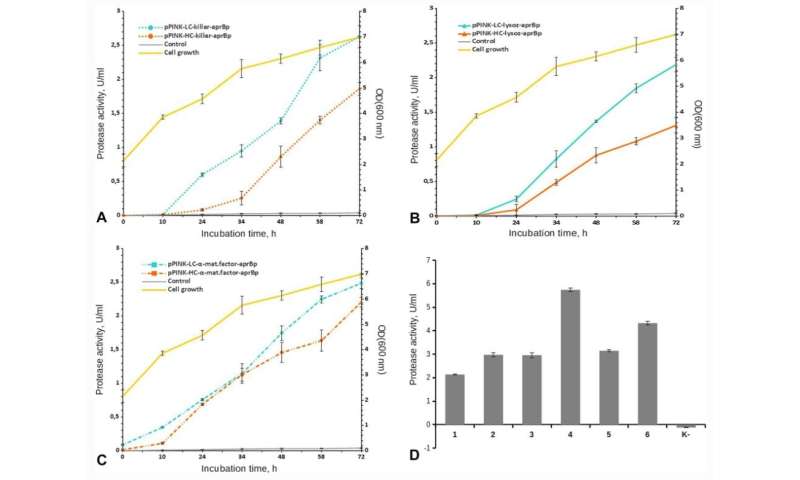Protease shows promise as feed additive for poultry farming

A paper by Kazan Federal University was published in BioNanoScience.
Proteases are one of the most innovative products used to improve the efficiency of feed additives. Due to their hydrolytic properties, they enhance the absorption of amino acids, which can reduce the protein content and the cost of feeds. The subtilisin-like proteinase (AprBp) of Bacillus pumilus 3-19 is a promising candidate for industrial use as a feed additive. However, in order to obtain a high yield of the enzyme, it is necessary to develop a highly efficient expression system. The aim of the study was to obtain stable expression of the B. pumilus 3-19 protease gene in the Pichia pastoris expression system and evaluate the correlation of enzyme activity with the choice of vector type and signal peptides. In this study, for the stable expression of the optimized protease gene in methylotrophic yeast cells, the vectors pPINK-HC and pPINK-LC were selected. For extracellular secretion of recombinant protease, a set of effective signal peptides was used. Presequence of the α-mating factor has repeatedly led to an increase in the secretion of recombinant proteins. On the other hand, the sequences of killer and lysozyme signal peptides have not been previously used for the expression of bacterial protease in P. pastoris. Colonies of transformants with constructs based on the pPINK-LC vector were detected on the 3rd day of incubation and showed higher transformation efficiency than for colonies with constructs based on the pPINK-HC vector, which were detected only on the 7th day of incubation. The transformation efficiency on the 10th day of incubation for structures based on the pPINK-LC vector averaged 1.3×103 transformants/μg DNA, while 1.03×103 transformant/μg DNA was recorded for constructs with the pPINK-HC vector. Colony PCR showed that all selected transformant colonies contained the subtilisin-like protease gene integrated into the yeast genome. The study showed that the incubation time affects the synthesis of protease in P. pastoris, and the maximum activity of the enzyme was observed. Yeast strains with constructs based on the low-copy vector pPINK-LC showed higher protease activity (U/ml) in the hydrolysis of azocasein (2.63 ± 0.16 for killer signal peptide (SP), 2.49 ± 0.08 for α-mating factor presequence, 2.19 ± 0.11 for lysozyme SP) than strains with constructs based on the pPINK-HC vector (1.86 ± 0.09 for killer SP, 2.21 ± 0.07 for α-mating factor presequence, 1.31 ± 0.11 for lysozyme SP), regardless of which signal peptide was used. The maximum protease activity was obtained for yeast strains with pPINK-LC-killer-aprBp (5.75±0.08 U/ml) and pPINK-LC-α-mat.factor-aprBp (4.33±0.07 U/ml) constructs. This study demonstrated that the subtilisin-like protease from recombinant P. pastoris strains exhibits proteolytic activity, which depends on the incubation time and the choice of signal peptide and vector. The production of bacillary protease by the heterologous yeast-based expression system makes this system promising for the development of new feed additives for animal husbandry.
Proteases are rated among the three largest groups of industrial enzymes and account for about 60% of the total global sale of enzymes, 40% of which belong to bacterial proteases. Bacterial serine proteases have wide substrate specificity, and high resistance to various conditions, which warrants their use in biotechnology, in particular as bio-additives for farm birds and animals. Additionally, supplementing feeds with proteases enhances the absorption of amino acids by animals and saves funds for the purchase of synthetic amino acids. It has also been shown that the use of proteases as feed additives increases the bioavailability of nitrogen, which in turn reduces the levels of ammonia pollution in the soil. Also, proteases facilitate the action of other enzymes and increase the cost-effectiveness of feeds, as well as promote the growth of beneficial microflora in the intestines of broilers.
Today, a limited number of commercial proteases from foreign manufacturers are used in Russia. The main representatives on the Russian market are the imported feed additives CIBENZA DP100 (NOVUS (88.1%), U.S.), RONOZYME ProAct (DSM (9.4%), Switzerland), Axtra PRO TPT (DuPont (2.4%), Germany). The obtained recombinant comprises P. pastoris strains with subtilisin-like bacillary protease (aprBp) gene and three different signal peptides (α-mating factor, killer protein and lysozyme). Further expression and purification of the protease from yeast culture liquid and the study of its biochemical and enzymatic properties will help assess the biotechnological prospects of the recombinant enzyme.
More information:
Heterologous Expression of Bacillus pumilus 3–19 Protease in Pichia pastoris and Its Potential Use as a Feed Additive in Poultry Farming
link.springer.com/article/10.1007%2Fs12668-021-00899-2
Provided by Kazan Federal University